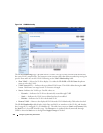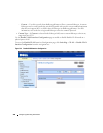
Configuring Switching Information 323
Each VLAN in a network has an associated VLAN ID, which appears in the IEEE 802.1Q tag in the Layer
2 header of packets transmitted on a VLAN. An end station may omit the tag, or the VLAN portion of
the tag, in which case the first switch port to receive the packet may either reject it or insert a tag using
its default VLAN ID. A given port may handle traffic for more than one VLAN, but it can only support
one default VLAN ID.
To displ ay t he VLAN
menu
page, click Switching > VLAN in the tree view. This VLAN
page contains
links to the following features:
• VLAN Membership
• Double VLAN
• VLAN Port Settings
• VLAN LAG Settings
•Bind MAC to VLAN
•Bind IP Subnet to VLAN
•Protocol Group
• GVRP Parameters
VLAN Membership
Use the VLAN Membership
page to define VLAN groups stored in the VLAN membership table. Your
switch supports up to 4094 VLANs. However, you can actually create only 4092 VLANs because:
• VLAN 1 is the default VLAN of which all ports are members, and
• VLAN 4095 is designated as the "Discard VLAN."
Valid VLANs that can be created are 2–4093. VLAN 4094 is reserved.
To displ ay t he VLAN Membership
page, click Switching > VLAN > VLAN Membership in the tree
view.


















